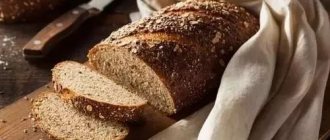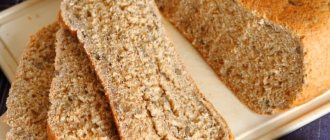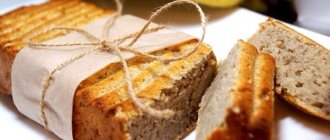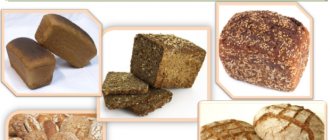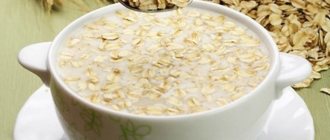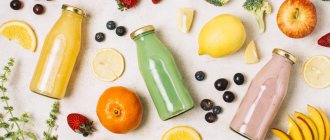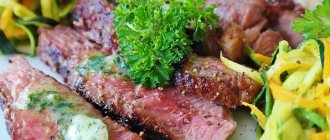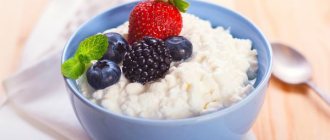Food, like clothing, has its own fashion trends. In the modern world, food trends change like gloves: white rice is replaced by brown rice; spaghetti - in no case made from flour, but from zucchini; no refined sugar - just muscovado. In the wake of all these trends, it was recently announced that yeast-free bread is a dietary and healthy alternative to yeast bread. The latter was presented in such an unsuitable light that all that remained was to exclude it from the daily diet, and when losing weight, not even think about it at all.
How true are these statements? Should we believe them and give up the fluffy loaf and soft loaf forever?
How to prepare
The name of the product speaks for itself: bread without yeast is made from flour and sourdough. It happens like this:
- in bunker dough-preparing units or batch dough mixing machines, sourdough is prepared from flour, water and bacteria (this is a multi-stage and multi-day process);
- the dough is kneaded in a special mechanism;
- the kneading process is carried out long and carefully so that the dough is saturated with air and is more fluffy;
- then it goes astray;
- unloaded into forms;
- goes to proof for a couple of hours (at 40°C and 85% humidity);
- usually baked at 230-250°C for half an hour to an hour (depending on the production technology used by a particular bakery plant).
The following ingredients can be used for production:
- leaven;
- flour (peeled rye, wheat, whole grain);
- seeds and nuts as flavoring additives;
- bran;
- salt, sugar (administered in the form of solutions);
- sunflower oil;
- dry wheat gluten;
- water.
However, each manufacturer has its own secret recipe. The following is used as a natural starter:
- whey;
- saccharified infusion of the carbohydrate-protein fraction of amaranth with hop cones;
- fruit purees;
- citric acid;
- a mixture of peeled rye flour, sugar, honey and water;
- hop mixture - a wort made from flour and malt.
The chemical composition of yeast-free bread is represented by such useful substances as:
- potassium, magnesium, phosphorus, iron, manganese, copper, selenium, sodium;
- vitamins B1, B2, B9, PP;
- cellulose;
- mono- and disaccharides (digestible carbohydrates);
- glutamic acid (amino acid);
- Omega-9 fatty acids (oleic).
The lower the grade of flour, the richer and healthier its composition.
Making bread at home
This product will require a starter. Its preparation will take about five days. It is good to use glass or enamel dishes with a lid for this. Bottled and boiled water are not suitable for production; ordinary tap water passed through a filter would be best. It is advisable to use coarse rye flour.
First you need to mix 100 grams of flour and 150 ml of water, mix thoroughly and leave for a day in a warm, dark place. After this time, add another 50 grams of flour and 50 ml of water and again leave to infuse for a day. The next day and the next, repeat the same thing. On the fifth day, again add 50 grams of flour and water, and by the end of these days it will be possible to bake bread from this starter.
Before the first batch, you should pour about 100 milliliters of the starter into a separate container. This starter can be used next time without first growing it for five days.
Making bread with wild yeast
To prepare the starter you will need:
- hop cones – 250 grams;
- water – 500 ml;
- flour – 130 grams;
- honey – 1 tablespoon.
Pour water over the hop cones and boil for an hour over low heat. Afterwards, leave the prepared broth to steep for about 8 hours. After time, filter through cheesecloth.
Add any flour to the resulting broth, it is better to use whole grain flour, and honey. Mix thoroughly, cover with gauze and leave to settle in a warm, dark place. After a day, the starter should approximately double in size.
Before it has time to settle, you need to prepare the dough. For this you will need:
- water or milk – 250 ml;
- honey or sugar - 2 tablespoons;
- prepared hop starter – about 10 tablespoons.
Best materials of the month
- Coronaviruses: SARS-CoV-2 (COVID-19)
- Antibiotics for the prevention and treatment of COVID-19: how effective are they?
- The most common "office" diseases
- Does vodka kill coronavirus?
- How to stay alive on our roads?
Mix all ingredients and add flour, bringing the dough to the consistency of low-fat sour cream. The dough should be similar in thickness to pancake dough. Cover the resulting mixture with a kitchen towel or linen cloth and leave for several hours until bubbles characteristic of fermentation appear. Add salt to the resulting dough and knead the dough with your hands, gradually adding flour if you plan to bake the bread in the oven. This bread is baked at a temperature of 160 to 200 degrees for about 45 minutes.
What is the difference between yeast-free bread and yeast bread?
Firstly, its effect on the body. It is believed that yeast-free bread is healthier because, unlike yeast bread, it does not disturb the intestinal microflora, is better absorbed and can be used in dietary nutrition, since it is lower in calories.
Secondly, properties. Yeast-free, for example, is stored longer and does not go stale, retaining maximum useful qualities. But yeast is more fluffy, softer and tastier.
Thirdly, the composition. It is believed that yeast-free food is richer in fiber and vitamins, since they are not spent on feeding yeast, which, as we know, are living organisms.
Yeast-free bread - briefly about the product
Bread products are one of the most ancient products consumed by humans. The history of this product goes back many centuries. Recipes for various baked goods can be found in almost all cultures and cuisines of the world. Properly prepared bread contains many beneficial substances for the body, and also perfectly saturates and eliminates the feeling of hunger for a long time - this is why the product is so widespread.
What is the increasingly popular yeast-free bread? In fact, such a product in its composition is practically no different from ordinary bread products , except that it is baked without the use of yeast, that is, bacteria that cause fermentation of the dough and give the bread its characteristic porous structure.
For a long time it was believed that yeast is very beneficial for the body and can saturate it with many vitamins and minerals, but recently this point of view has been questioned by nutritionists.
It is widely believed that yeast used in the food industry contains harmful substances and toxins that are hazardous to health, and can cause stomach upsets and also provoke cancer. It is worth saying that debates about the effects of yeast on our body are still ongoing, and there is no consensus on this matter.
Contrary to the name, a yeast-free product also contains fungi, although in a slightly different form - as part of a natural starter.
Myths and truth
Until recently, the question of which bread is healthier: yeast-free or yeast-free bread did not raise any doubts. And even now most people will choose the first option. This point of view has been discussed and explained in detail above. However, recently more and more experts have disputed this point and claim that this was nothing more than a marketing ploy by the manufacturers. They provide quite compelling arguments as evidence.
Argument 1: sourdough also promotes fermentation
Compressed yeast is used to produce regular bread. They are created specifically to speed up the baking process, as they contribute to the rapid “ripening” of the dough. Having discovered the harmful properties of fermentation (allegedly it disrupts the intestinal microflora and impairs digestion), manufacturers hastened to announce this to consumers and began to produce yeast-free products based on sourdough. But the latter is a semi-finished bakery product obtained by fermenting a carbohydrate mixture (flour, water, sugar and honey) with lactic acid bacteria. That is, the fermentation process still occurs, which means that yeast fungi are also present there.
So when asked whether there is yeast-free bread, baking industry technologists will answer unequivocally: no! But there is such a dough. Everyone is familiar with its types: pancake, puff pastry and soda. However, the first one is intended for frying, which means it no longer fits into either proper or dietary nutrition. The second is prepared on the basis of oil, which gives it a high calorie content. Soda products often provoke heartburn and unpleasant belching, and also have many contraindications.
Argument 2: yeast is all around us
If you think that by refusing yeast dough, you have completely protected yourself from the harmful effects of this product, you are deeply mistaken. Yeast is present in the air, on the surface of fruits and vegetables, and one way or another they still end up in the digestive tract. In addition, everyone’s favorite drinks are prepared on their basis: kvass, wine, beer.
Argument 3: there is no yeast in the finished product
Any baked product is baked at high temperatures, at which living yeast fungi die, and in this state they cannot in any way affect the intestinal microflora.
Argument 4: there is no more fiber in yeast-free bread than in yeast bread
This is evidenced by recent research. The amount of fiber in a baked product depends on how much bran and grains it contains, but this has nothing to do with yeast microorganisms.
All these points become stumbling blocks for disputes. Manufacturers say one thing, scientists say another. There is no consensus and large-scale studies with conclusions, so you can only rely on such assumptions. But in any case, it’s strange to hear that yeast is so harmful to the body, because it is even sold in the form of a pharmaceutical preparation as a source of B vitamins. Moreover, they differ from their bakery counterparts only in the form of release and additional additives, but not in properties.
About bread with yeast and without yeast. Archpriest Maxim Obukhov answers
Fashion and popular trends exist not only in clothing, music, but also in nutrition. From time to time, butter is “rejected” because it is harmful to blood vessels, then it is “allowed” again because it becomes beneficial for the skin; today many people refuse gluten... Almost a war has broken out around yeast dough. The question of yeast is important for us, since prosphora and artos are prepared from yeast dough. We asked Archpriest Maxim Obukhov, head of the Orthodox medical and educational center Life, to help figure out why yeast is being attacked, where are the myths, where are the facts.
– How long ago did the fight against yeast begin?
– For a long time now, approximately since the beginning of the 90s, panic texts have been disseminated in various media about supposedly baker’s yeast being harmful and even deadly. In similar materials they write that yeast does not die during baking (which is about 200 degrees). That is, we eat live cultures that are harmful to the body. And, accordingly, opponents of yeast conclude: eat yeast-free bread, then you will be healthy. It's hard to track down who started this rumor first. But the horror story spreads virally and takes on a life of its own. The noise around this topic can be described with words from A.S. Pushkin’s fairy tale: “Rumor ran before him, Fables and fables were revealed... »
It is unclear what motivated the people who came up with all this, but over the years the myth acquires more and more details, like the fear of ghosts and subconscious horrors. Now this fairy tale lives and multiplies in people’s heads, and some infect others. But inciting phobias is a classic technique for manipulating people. And manipulation, as a rule, pursues some goal: to increase one’s authority, to present oneself as a savior from the worldwide horror of a yeast invasion, and then, for example, to sell you something...
– What type of microorganisms are yeasts?
– There are several kingdoms of living things, including bacteria, fungi, plants and animals. Therefore, when we talk about microorganisms in general, it is rather an assessment of their size. Mushrooms are a numerous taxonomic unit; it includes a fairly large number of organisms, both unicellular and multicellular, including mold, yeast, and including mushrooms, such as champignons and boletus. These are thousands and thousands of different organisms. Some of them are pathogenic, some are harmless, and some are beneficial, such as yeast.
We find yeast everywhere. They are found, for example, on the surface of grapes. Everyone noticed a whitish coating on it; these are billions of yeast cells. And even after washing a sweet and healthy product, we do not get rid of these microorganisms, but none of us died or got poisoned after eating grapes or any other fruits or berries with yeast. There are even recipes for yeast bread, where the source of yeast is grapes: knead flour, and add clean grapes, straight from the branch, not treated with pesticides, to the dough and after some time you get yeast dough.
– What value does yeast have from a medical point of view?
– Brewer's yeast, baker's yeast, dried and killed by heating, is a classic pharmacopoeial medicine, a vitamin supplement that was used during the Great Patriotic War due to its low cost. After all, yeast can be obtained from waste, for example, from beet production. This is a good product that is suitable for weakened patients as a vitamin supplement. Yeast is good because it is balanced in various vitamins, for example, group B, which is very beneficial for the nervous system. Many people have probably also been advised by their doctor to use yeast for barley. Yeast is also a source of protein, perfect during protein hunger.
Yeast bread has been around as long as humanity has been eating wheat bread. People have long noticed that yeast bread acquires a pleasant smell, it is tasty, and yeast fermentation makes baked goods better and more nutritious.
– Are there any diseases for which yeast bread is contraindicated?
– Individual intolerance can be to any product. Fish is contraindicated for one person, another cannot eat bread, someone else excludes citrus fruits from the diet, and for others, some other foods make them feel bad. Intolerance to certain types of medications occurs. In general, yeast bread is a universal food item. There may be an intolerance to some components of the bread itself, the grain, but again, when baking, even at a temperature much higher than 100 degrees - lower than in the oven when preparing bread, the yeast dies. That is, even if the bread is not baked, but the pulp has warmed up to 100 degrees, we do not consume live yeast. “Thermophilic yeast”, discovered by the creators of myths, which supposedly can withstand either 300 or 500 degrees, is nothing more than a fairy tale: protein is irreversibly destroyed starting from 60 degrees. “Thermophilic yeast,” of course, does not exist. It would be interesting to know who was the first to launch this duck...
And yet, it’s worth noting separately: if you eat live yeast, nothing bad will happen. Probably many people remember how in childhood their mother made dough, and the children took a piece from the table and into their mouths. Also, when yeast used to be sold in briquettes, children would bite off a “brick” and eat it. And there were no problems.
The worst thing that can happen is that if you eat a piece of raw yeast with something sweet, then there will be fermentation for some time and a small amount of alcohol will be formed. But there is so little of it, and plus, under the influence of gastric juice, the activity of yeast stops. Everything is simple here: yeast cannot live in the conditions of our digestive system, because we have hydrochloric acid in our stomach.
– Prosphoras are baked from yeast dough. Why is yeast bread important for Orthodox church life, and not unleavened bread?
– This is due to the peculiarities of the Orthodox tradition. For the Eucharist, lithium bread, artos, according to the charter, only yeast (leavened) bread is used (see Uchitelnoe News). This emphasizes the New Testament parable of leaven (Matt. 13:33). This is how our tradition differs from Western Christianity, and in Church Slavonic, kvassnoy means yeast.
For some reason, the theory of the “impurity” of yeast is spreading in the near-Orthodox community. Proponents of the “yeast conspiracy” preach the theory that it is something nasty, dirty, disgusting, harmful and dangerous. This is very strange considering that the wine and bread used in the Eucharist are leavened products. Thus, when they talk about the impurity of yeast, they blaspheme the sacraments. One of the “Orthodox elders” published an article in which he stated that yeast is mold, and the Eucharist on yeast bread is invalid... Others are starting to sell or transfer “holy leaven” to each other, in short, the matter smells of mass psychosis and hysteria. In the past, until the 19th century, people did not know the nature of yeast, since there was neither a microscope nor microbiology. But when the nature of this phenomenon was discovered, it turned out that leaven and yeast are what we see with our eyes. Yeast and leaven are one and the same thing, and the fermentation process in dough, beer and wine is the vital activity of these microorganisms, accompanied by the release of carbon dioxide and alcohol.
In the Middle Ages, there was controversy between Azimites and Prosimites, between supporters and opponents of the use of yeast bread. Let me emphasize once again that all Orthodox rules stipulate the use of only yeast dough! It is also worth remembering that bread (and in the Russian tradition it was always yeast) is a cultural symbol, and has always been more than just a product, rather even a sacred symbol, and everyone still knows that it is not good to throw away bread, children are forbidden to play with bread and etc. New inventions about the danger of yeast play a peculiar role in desacralizing one of the foundations of people's life.
– They say that sourdough bread is healthier than yeast bread. Is there a fundamental difference?
– Previously, they used yeast culture through sourdough. A piece was taken from the previous dough and stored in some cool place. When making the next leaven, we took this piece and added it to the dough. This, of course, is not a pure culture and contains impurities of lactic acid bacteria. Now that we have industry, knowledge, microbiology, the same yeast can be obtained in its pure form, without impurities. The yeast we buy is the same as sourdough, or with grapes, there is little difference. Why does dough with commercial yeast rise faster, but with sourdough it takes several hours? The answer is very simple. The point is their number and activity. When you add store-bought yeast, you get such a large number of cells that you don’t have to wait long, the dough rises quickly. But with sourdough it is different - there is a relatively small number of yeast cells. Therefore, you need to wait until they reproduce. That's the difference.
– Yeast opponents even call yeast dirt that can cause diseases (candidiasis, for example). Is this legal?
– This is what people who have not studied this issue say. Microbiologists and doctors have studied most infectious diseases and identified their causative agents. Back in the 90s of the 19th century, the so-called Koch's postulates, which laid the foundation for medical microbiology and the study of infectious diseases. To prove that a particular pathogen causes a disease, it is necessary to isolate it and prove the connection between the disease and the activity of this microorganism. That is, every infectious disease has a specific pathogen. In the pseudoscientific works of yeast opponents, phrases such as “yeast-like fungi,” “mold,” and “candidiasis” are written. But they get confused and don’t understand that fungi are all general words, like saying that my wild animals eat chickens. What animals? Moose? African elephants? Probably the chickens are being strangled by foxes and ferrets. Also, a disease is caused by a specific pathogen, and to call it a general word means to say nothing. The concept of “mushrooms” includes a variety of organisms that have different properties. Just like saying an insect is an understatement, because insects are also different - a grasshopper, a fly and a mosquito. Opponents of yeast are confused: candidiasis and thrush are caused by pathogenic or opportunistic species of fungi, but yeast is not one of them. Candidiasis occurs mainly as a result of dysbacteriosis, disruption of the microflora in certain parts of the body, and abuse of antibiotics.
The medical literature does not describe diseases that would be caused by baker's yeast. You can say whatever you want, but until these statements are proven by clinical trials, they will relate to assumptions, guesses, theories, but not facts. Please note: there is no evidence of harm caused by yeast and yeast bread.
– There are people who consider the mushrooms that we eat to be aliens, and they enter our bodies and begin to dictate their will
- It's a phobia. This is not a question of biology, but of psychiatry. There are people who are afraid of ghosts, and sometimes they are afraid of worms, insects, bacteria. Mental disorders occur when a person sterilizes everything around him. It gets to the point that before opening the door, the handle is wiped with a cotton swab moistened with alcohol. Hands are not washed with soap, as all people usually do, but treated with alcohol. Such neuroses and psychoses have been well and thoroughly studied and described in the medical literature in the relevant sections. This has nothing to do with microbiology.
– What other myths exist around yeast or what are they accused of?
– There is an opinion that there are good yeast and bad. True, no one explained where and what kind of yeast is located.
There are a number of misconceptions about yeast, one of them, common, is that yeast-free bread is sold. But only the word “yeast-free” must be put in quotation marks! What does it mean? According to the sellers, they use sourdough, believing that it is not yeast. In fact, their bread is yeasted, made from sourdough yeast. Exactly the same yeast as in the store. The quality of bread, in addition, strongly depends on the initial components, namely grain, flour and production technology. Sellers of supposedly yeast-free bread are essentially misleading buyers. If you want to see real yeast-free bread, this is lavash. It does not contain air bubbles characteristic of yeast baking. The dough for the pita bread was kneaded and baked right away.
They come up with all sorts of horror stories and tales about yeast! What is this horror story worth: the Nazis grew yeast on human bones or pork cartilage. But these are all fairy tales, since there is not a single document on this matter. Microorganisms are renewed, and even if we assume (just assume) that someone once used bone meal, then it has not been in the yeast for a long time. Within a day, several generations will change in a culture. It's even funny! Microbiological scientists do not spend their time refuting or debunking such myths. It's kind of like the flat earth theory. Would a self-respecting physicist dispute it?
There are also references to pseudo-medical sources, to authorities who bought the titles of professors and academicians from a diploma factory like the “World Academy of Natural Sciences.” Diplomas and academic titles are bought for the purpose of deception. By the way, one of the creators of myths about the dangers of yeast is a medical fraudster with purchased titles, an artist who has nothing to do with medicine. The price of these diplomas is the cost of the paper on which they are printed.
Another myth is the passion surrounding the technical conditions for yeast production in factories. For example, they write that certain substances can be used in the production of yeast - washing powder, formaldehyde, sulfuric acid, lime, urea. This is true, in production they work with these substances, but this does not mean that they are in the yeast and end up in the bread. Reactors where yeast multiplies need to be washed; they are washed with washing powder or sterilized with formaldehyde. Just like a piglet, if, say, they wash it in a pigsty with washing powder or some other product, and then prepare a meat dish from it, this does not mean that the powder is present in the meat. And sulfuric acid and lime are needed to bring the acidity to a neutral value. In the production of yeast, some harmless sources of nitrogen are always used, which is not found in sugar, and air nitrogen is not absorbed. Also, after yeast multiplies on waste from the sugar industry, it is subsequently purified of impurities. Whatever gets into the yeast, whatever components are used, after filtration we get a pure culture without impurities.
– Father Maxim, what advice would you give to people who are afraid of yeast?
– I would like to say to those who listen to myths, rumors about yeast, experience fear, disgust, and are victims of suggestion. Pay attention not to YouTube comments, pseudoscientific articles, manipulators, but to medicine and research conducted by specialists according to certain standards. No one will argue that medicine is an evidence-based science, and since there is no evidence that yeast is harmful, then there is no need to be afraid. There are many real health threats that you really should be afraid of... And just remember: if yeast were harmful, then humanity would have died out several thousand years ago. People have been eating yeast bread since ancient times, almost since the Stone Age.
Text: Alexandra Gripas
Please note that the information presented on the site is for informational and educational purposes only and is not intended for self-diagnosis and self-medication. The selection and prescription of medications, treatment methods, as well as monitoring their use can only be carried out by the attending physician. Be sure to consult a specialist.
Benefits and harms
Why is it useful?
It is believed that the main benefit of yeast-free bread is to normalize digestion, due to the increased fiber content, which:
- cleanses the intestines and removes harmful substances and stagnant masses from it;
- stimulates peristalsis, which improves the absorption of the rest of the food several times;
- relieves intestinal disorders (flatulence, bloating).
Due to the fact that the body begins to absorb vitamins and microelements in full, the immune system is strengthened and the risk of developing infectious diseases is reduced.
Yeast-free bread also exhibits its beneficial properties in cases where there are contraindications to yeast bread. For example, with gastritis, ulcers and other serious diseases of the gastrointestinal tract, yeast causes heartburn. If you abuse it while breastfeeding, the baby will suffer from colic, bloating, and may develop diarrhea. But a yeast-free product will not cause such side effects if consumed in moderation.
It also turns out to be useful for diabetics, since it has a low glycemic index compared to other types of bakery products. For these people, almost all types of bread are prohibited, which has an extremely adverse effect on the body, which requires fiber. In this case, you can use this alternative. But do not forget that it is still a carbohydrate, so it is not recommended to get carried away with it. It would be better to consult a doctor about its use.
Why is it harmful?
Nuts and various seeds in unleavened bread can damage the thin walls of the intestines. Therefore, it is better to purchase it without such “surprises”. It can also worsen the condition with exacerbation of pancreatitis and gastric diseases (the same gastritis and ulcers mentioned above). Often, due to its too dense consistency, it scratches the throat, so doctors do not recommend eating it if you have a sore throat or problems with the vocal cords.
Main contraindications and harm to the figure
Harm to the human body when using yeast-free baked goods as food can only be due to the use of a low-quality product. Manufacturers often add hop cones or willow twigs to the starter - such products are no longer considered yeast-free. But still, such bread is healthier than usual, although such yeast is not much different from baker’s yeast. Therefore, people with allergies to hops and other components in sourdough should beware of this product.
To avoid buying low-quality bread, it is recommended to bake it yourself, following the technology of leavening the dough.
It is also necessary to remember that there is a norm of consumption - 100-250 g. If you adhere to this norm, it will have a positive effect on the digestive organs and will benefit your figure. Nutritionists recommend that if you are overweight, eat sourdough rye bread, which has low calorie content and is more beneficial than white bread.
If you constantly consume only the highest grade wheat product, even without adding yeast, then weight loss will be very difficult to achieve. An alternative could be bran cakes and breads or products made from low-grade wheat flour.
Flatbreads can really be a substitute for traditional baked goods and benefit the body
If you consume this type of bread uncontrollably, you can provoke disturbances in the functioning of the digestive organs: constipation and abdominal pain, stomach pain and prolonged digestion of food, severe belching and a feeling of a full stomach. If there are chronic pathologies in the gastrointestinal tract, then the risks of exacerbations increase several times.
Baking with sourdough is contraindicated for the following pathologies:
- gastrointestinal ulcers;
- gastritis with high acid content in gastric juice;
- disturbances in the functioning of the pancreas, pancreatitis;
- intestinal obstruction;
- inflammation in the intestines.
See also:
Cabbage pie for the lazy - the best step-by-step recipes
Advantages and disadvantages
Pros:
- has a natural composition: does not contain synthesized ingredients, dyes, preservatives, flavors;
- good for health;
- fits into dietary menus;
- easy to digest;
- long shelf life;
- recommended for baby food.
Minuses:
- unusual taste with sourness;
- there is no usual bread aroma;
- dense consistency, no fluffiness;
- damages gums due to dryness;
- not suitable for those who have dental problems;
- costs more than usual;
- It is difficult and time-consuming to cook at home.
What does yeast-free bread provide?
Flaws
Yeast-free baked goods, despite their beneficial qualities, are still inferior to yeast baked goods in some respects. For example:
- Smaller product volume – with the same weight, the volume of a yeast loaf is almost twice as large as a yeast-free loaf. The buyer automatically chooses the product that seems larger to him.
- Absolutely different taste of baked goods. We are all accustomed to the aroma and taste of yeast baked goods, so not every person will like the taste of the new product.
- Hardness of bread. People who have problems with teeth and gums should avoid this product. But bread is not always hard and dense; there are quite soft varieties made with sourdough.
- Complex manufacturing technology that requires more time and production processes. First of all, you need to prepare the sourdough, and dough with sourdough takes much longer to prepare than with yeast. The production process of yeast dough is simple: yeast and baking powder are added to the flour and the bread is ready within an hour.
Is it possible to make yeast-free bread while losing weight?
Those who are losing excess weight are constantly wondering whether they can gain weight from unleavened bread and whether it is possible to include it in their diet. If you choose the product wisely and use it correctly, it can even be beneficial for your figure, since:
- Fiber has a beneficial effect on digestion. Thanks to this, fats are used to produce the necessary energy, and not in reserve.
- It helps cleanse the body of toxins. This accelerates metabolism and starts the fat burning process.
- It provides long-lasting satiety, which allows you to endure until the next snack without attacks of unbearable hunger. This reduces the risk of failure.
However, in order to correctly include this product in the diet menu, you need to know how many calories are in yeast-free bread, the ratio of BJU and what its glycemic index is. These indicators largely depend on what flour and what leaven it was made from.
For example, in yeast-free black bread:
- calories - 199;
- glycemic index - 35 units;
- BZHU - 5.6/1.4/36.4 (in grams).
For yeast-free white (wheat):
- calorie content - 225 kcal;
- glycemic index - 45 units;
- BZHU - 8/1/46.
According to these indicators, both the GI and calorie content of unleavened rye bread are more suitable for weight loss than the characteristics of wheat bread. But they will largely depend on the recipe, in particular, those ingredients that a particular manufacturer uses. Therefore, carefully read the composition of the product that you have your eye on. If the starter is made from honey and sugar, it definitely has no place in the diet menu.
Helpful advice. Even if the package says: “dietary yeast-free bread” - don’t take its word for it, be sure to check both the calorie content and composition. Otherwise, instead of losing weight, you will gain a couple of extra pounds on your sides.
Is it possible to lose weight with whole grain bread?
The benefits of whole grain bread are obvious. But many people are interested in how harmless it is for the figure. Can I use it while dieting? It is not entirely correct to say that it is completely harmless. Here, too, you need to be careful with the amount you eat. Because whole grain bread is a nutritious product. However, it is really lower in calories, much healthier than usual, since it contains more vitamins and minerals. Moreover, it does not increase, but on the contrary, lowers cholesterol levels.
All of the above and a low glycemic index allow the use of whole grains in diets. Many nutritionists recommend including it in the menu when losing weight. For example, in the Dukan Diet, a whole grain option is mandatory at certain stages.
But you must adhere to certain rules:
- Do not exceed the amount indicated by the nutritionist.
- Use it only in the morning and afternoon.
- Buy a whole grain product, and not a version made from white flour, but with various additives.
Following these rules will help you make the most of the beneficial properties of this product and make it completely safe for your figure.
Which to choose
On the shelves of modern stores you can find a wide variety of brands of yeast-free bakery products. Here are just a few of them:
- Boyarsky, Merchant, Peasant, Noble, Aromatic (Riga Bread Company);
- Multigrain Kaiser (Smak);
- Classic Riga custard, rye-wheat, lean (Bread Shtetl);
- Dobry (Slutsk loaf);
- Krepysh, rye custard (Volzhsky baker);
- Bogatyr, Krasnoyarsk, Slavic, Starorussky (Yarkhleb).
The market leader is considered to be: they have in their assortment more than 30 types of yeast-free bread made from different types of flour and with numerous additives.
Armenian lavash (236 kcal), Jewish matzo (312 kcal) and Ukrainian bread (198 kcal) are also prepared without yeast. The first two options have excellent taste, but their high calorie content does not allow them to be used for weight loss.
Criterias of choice:
- the composition should not contain sugar and honey;
- not expired;
- no mold;
- when pressed with a finger, elasticity is felt, not softness;
- vacuum packaging.
If you choose it for weight loss, the calorie content should not exceed 200 kcal per 100 g of product.
What are the benefits of yeast-free bread
So, what are the benefits of yeast-free bread? If we talk about the beneficial properties of such a product, then first of all it must be said that it does not have the disadvantages that a yeast product has. And all other components in it are absolutely identical. As for the disadvantages of yeast, the whole point here is that nutritional yeast has a number of negative properties that affect the human body. That's why it's more useful.
If we talk about the advantages of a yeast-free product, then it is very well absorbed by the human body and the digestive process takes place without any disturbances. There are several reasons for this, but the main ones are that such a product is dense and rough. When the crumb of dense consistency ends up in the food bolus, the work of the intestines begins to rapidly become more active, and at the same time intense activation of the muscles of the digestive tract organs also begins.
This leads to the fact that food is absorbed better by the body, and in addition there are undoubted advantages for the intestines, since grinding rough food, it strains, which prolongs its youth and it remains healthy for a long time.
Continuing the conversation about the benefits of such a product, we cannot help but say that it is in no way capable of harming the intestinal flora. The fact is that ordinary dough contains a large amount of yeast, which causes frequent changes in the number and composition of a wide variety of bacteria. This ultimately causes various kinds of problems in the digestive system, and quite often serious dysbiosis can occur, which is really bad. And if a person consumes yeast baked goods, then there is no need to fear such consequences.
It should also be said that if a person eats a lot of baked goods containing yeast, then flatulence often occurs. Yeast, which contributes to the swelling of the dough, forms a large number of cavities in it that contain carbon dioxide, which causes a significant increase in the formation of gases in the human intestines. As for the product without yeast, there are no such consequences, which is also in its favor.
It should also be said that if we consider the composition of such bread as a whole, it contains more substances that benefit the human body. And this is easy to explain - a certain proportion of sugar and other substances is not spent on feeding the yeast itself.
There is often an opinion that baked goods that do not contain yeast contribute to the formation of oncology, however, such an opinion has no evidence base, so there is no point in considering it seriously. But as for the beneficial properties of such products, they have been proven from a scientific point of view, so there is no reason to doubt it.
It seems that such a product is a truly healthy food. A lot of energy, easily absorbed by the human body, a lot of useful properties for the human body. However, its spread has not yet been able to displace ordinary bread, which is made using yeast, from consumption, despite the fact that it is far from being as healthy for health.
Special Recommendations
We will answer frequently asked questions.
How to store?
Due to the fact that yeast-free bread has a longer shelf life than yeast bread, many consider it almost eternal. Although it spoils and causes various intestinal disorders. On average, from the date of release it remains edible for 10 days (plus/minus depending on the production technology and composition).
Does unleavened bread get moldy?
Yes, but only if it is not stored correctly (keep it open next to other products on which fungus quickly multiplies), and also after the expiration date. If immediately after opening the package you place it in a plastic container, then it will retain its beneficial properties for a long time and will not deteriorate. Although this only applies to truly high-quality products.
How much can you eat?
The daily norm for weight loss should not exceed 150 g; for the usual diet of a healthy person it increases to 250 g.
What's better to eat with?
Yeast-free bread can be combined with the same products as yeast bread. But its dense and rather rough texture sometimes makes it unsuitable for sandwiches. But it will be just perfect as a snack with porridge for breakfast or with soup for lunch.
When is the best time to eat?
Like any carbohydrate - in the morning, for breakfast and lunch. It is no longer advisable to take it for dinner, and just before bedtime it is not recommended at all, as it can overload the stomach and disrupt the digestion process.
Benefit for health
- Firstly, it is worth saying that eating yeast-free bread is quite beneficial for health, namely for the normal functioning of the gastrointestinal tract . The product improves the functioning of the digestive system, stimulates intestinal motility, and helps remove accumulated toxins from the body.
- The technology for making yeast-free baked goods is such that it significantly reduces the risk of poisoning and various gastric disorders . It is believed that the sourdough used in baking is much healthier and is thoroughly purified from various harmful impurities and toxic substances.
- The product is very useful for the prevention and treatment of constipation , bloating, and increased gas formation.
- It is worth saying that in yeast-free products, as in all types of bakery products, the content of B vitamins is quite high. These vitamins play an important role in the metabolic processes occurring in our body. In addition, the vitamin is also useful for the normal functioning of the digestive system.
- A lack of B vitamins negatively affects the nervous system and can cause mental impairment and sleep problems. The bread product helps combat these problems.
- It would not be amiss to mention that the calorie content of a product prepared with sourdough is much lower than that of ordinary white bread. So, 100 grams of the product, as a rule, contains no more than 190 calories , while a serving of a product made with wheat flour contains almost 240! Thus, the product is recommended for use by those who are on a diet and want to get rid of extra pounds (but not exceed the recommended amount).
- Eating bread in moderation is good for cardiovascular health , since the product contains heart-healthy minerals: potassium and magnesium. They strengthen the heart muscle and make blood vessels stronger.
- A yeast-free product is much less likely to cause heartburn and is allowed even for those who suffer from gastritis or ulcers. Pregnant and lactating women, as well as people suffering from bloating or increased gas formation in the intestines, can eat this bread.

